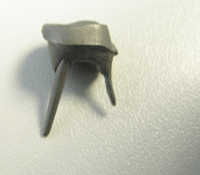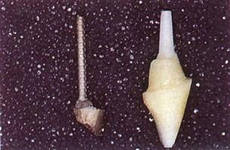Stump Tab

The stump tab is a specially designed dental design with an artificial crown on which an artificial crown is subsequently fixed. Used to restore badly damaged teeth.
The stump pin tab consists of the crown and root parts. Its root part is fixed in the root canal, the crown part is similar to a tooth stump and has already been prepared for the crown.
The stump insert, in contrast to the pin, is installed in a few steps, but its use ensures that the tooth does not exactly break and will no longer collapse.
The pin-stump tab distributes the load on the tooth evenly, this is its main difference from the pin.
Fixing the tab on a special cement composition ensures a tight fit of the structure to the remains of the tooth and prevents the formation of cracks.
Kinds
According to the manufacturing method, stump tooth tabs are cast and collapsible.
Stump cast tab

It is made at high temperature and under pressure. It consists of the main part, which restores the tooth, and the fixing pins, with the help of which the tabs are fixed in the dental canals.
Collapsible Stump Tab
It is made if the root of the tooth has three or four channels. Some pins are made removable, because they cannot freely enter the root canal. This tab is almost no different from the cast. The collapsible tab fits perfectly into the shape of the tooth. After installing it, removing the stump tab is unrealistic. In this regard, a lifelong guarantee is established on collapsible stump tabs.
Depending on what material the stump tab for the crown is made of, the following types of structures are distinguished:

- Stump metal tab.
It can be made from chromium - cobalt alloy, from precious metals and their alloys. Such tabs are more reliable than structures made of composite materials, but are unaesthetic. Therefore, they are more often placed on chewing teeth and they do not fall into the line of a smile. Gold inlays - the best option for the restoration of chewing teeth.
- All-ceramic tab.
Designs are made of pressed ceramics and zirconia. Stump zirconia inlays are not inferior in strength to metal inlays, and inlays made from pressed ceramics are identical to porcelain in aesthetics. The manufacturing process of all-ceramic structures is fully automated, which completely eliminates the formation of secondary caries. For restoration of the anterior teeth, the stump tab on the anterior teeth is used.
- Stump ceramic-metal tab.
The quality of such tabs is worse, because they often drop out.This is explained by the difference in the thermal expansion of metal and ceramics.
- Composite tab.
Now such tabs are used very rarely, since the quality is no different from ordinary fillings, although their cost is higher.
Stages of making a stump tab

- Preparing the tooth for casting. Preparation under the stump tab is performed using a drill. To do this, remove all tooth tissues affected by caries and form a cavity under the tab. They give her a certain shape.
- Removing a mold from teeth. In the laboratory, according to the cast, a dental technician casts a plaster model of teeth.
- Scanning the model area with the prepared tooth.
- Computer simulation of the cult tab.
- The computer transfers the three-dimensional model to the milling machine, where the “cutting” of the ceramic tab occurs.
- Firing blanks in special furnaces.
- Fixation of the stump tab on the tooth.
Indications for installation
Stump Tab only possible if the tooth root has survived.
Indications for the use of stump tabs:

- Destruction of the crown of the tooth.
- Defects in the shape and position of the teeth.
- Defects of the supragingival region of the tooth, having a different origin.
- The inability to restore dental crowns using filling materials or other methods.
- As a support for the installation of a bridge.
- In case of periodontal disease, as a splint construction.
Contraindications
The stump tab has some contraindications for use:
- Gum disease at the site of the establishment of the stump tab.
- Damage to the root of the tooth.
- The presence of pathological tooth mobility.
- Poorly treated root canals.
- An allergic reaction to the alloys from which the structure is made.
How is the installation

- Preparing the tooth for the installation of the stump tab. For this, endodontic therapy is performed. The root of the tooth is carefully filled to the very top, which is confirmed by x-ray.
- Unsealing the roots one third or half the length of the root. The channel is tapered and wide.
- Casting of both jaws so that the future tab was made taking into account the ratio of teeth - antagonists.
- A gypsum model of teeth is made in the laboratory and a wax stump tab is modeled.
- The stump tab is cast and transferred to the dentist's office.
- Fixing the finished stump with cement. Immediately before installation, the tab is thoroughly degreased. The tooth is treated with alcohol and thoroughly dried. Using a channel filler, root canals are filled with cement. The cement mortar covers the tab with the pin and is installed in place. Then, if the structure is collapsible, then additional pins are covered with cement and are located in the desired root canals. At the end, the entire tab is carefully pressed.
Recovery and rehabilitation
- Since teeth are prepared before prosthetics with a dental stump insert, complications such as secondary caries or pulpitis may develop after the design is installed.
- In some cases, pain is noted.
- To prevent such complications, it is necessary to strictly follow the recommendations of the dentist.
Video: “Removing the stump tab from the tooth”
FAQ
It is often difficult for patients to decide on the choice of material for installing stump tabs.
When choosing, it is necessary to take into account the condition of the patient's oral cavity, the aesthetics of the structures, the compatibility of the materials from which the stump insert and the tooth crown are made.
Answers of specialists to frequently asked questions of patients will help to make the right choice.
- Question: What material is better to make a cult tab from? Everyone advises gold, is it right?
Answer: Gold tabs are biocompatible and transmit a uniform load to the root.
- Question: How durable are the tabs, they say that their service life is from 5 to 10 years, is that so?
Answer: Tabs can last a very long time with proper care. The most durable are gold and zirconium stump tabs.
- Question: What material is better to put a crown on a stump tab?
Answer: If the stump tab is made of ceramic, then the crown should be made of the same material. If the tab is metal, then the crown should be made of metal. Ideally, the materials should be identical.
Pros and cons of stump tabs
Stump tabs have several advantages over other designs:

- Strength and reliability of fixation.
- Large selection of artificial crowns.
- The ability to give the right shape to the tooth.
- In some cases, the correction of the position of some teeth is possible.
- The installation of bridge structures is simplified.
- They are used for the destruction of any teeth.
- There is no access for bacteria, which prevents the development of inflammatory processes in the gums and the destruction of tooth tissues.
- An artificial crown can be easily dismantled and another one installed in its place.
- Excellent aesthetics when using ceramic inlays. A zirconia stump insert can be used to restore anterior teeth.
- Long service life.
Disadvantages of stump tabs:
- The high cost of designs.
- The need to remove a large part of the living tissue of the tooth to ensure a perfect fit of the tab.
Stump Tab Care
- After installing the stump tab, it is necessary to observe hygienic care for the oral cavity. Teeth should be brushed at least twice a day using a toothbrush with toothpaste.
- To clean the surface of the tooth structure and adjacent gums, it is better to use a soft-bristled toothbrush. Using a brush - brush and floss, you can clean the interdental spaces.
- After each meal, the mouth must be rinsed with warm water, or with a special solution that has anti-inflammatory effects and freshens the breath.
- At least twice a year, it is necessary to visit the dentist's office for a routine examination.
Stump Tab Prices
Dental tabs are a fairly expensive prosthetics method.
More affordable is the cobalt-chrome stump tab cost, which is lower than that of precious metals and ceramics.
| Stump tab view | Price in rubles |
| Single-root metal tab | 2000 |
| Two-root metal tab | 3000 |
| Pressed ceramic tab | 12000 |
| Zirconia Stump Tab | 15000 |
Life time
With proper hygienic care for the stump tab, the service life is 10 years or more.
Gold stump tab has a lifetime more than 15-20 years.
Reviews after setting the cult tab
- A week ago, the dentist put stump tabs on the 6th and 7th teeth. The channels of the 6th tooth were treated more than four years ago. Before prosthetics, the teeth did not hurt. After installing the stump tabs, I suffer from toothache. At night the pain intensifies, the whole jaw hurts.
- I have a stump tab installed on the front tooth, which I constantly feel, and it bothers me.
- I put the stump tabs on two chewing teeth made of silver - palladium alloy. I feel fine. And I also had a problem with another chewing tooth. Prior to this, there was a pin, which was inserted not into the root canal, but past. They put me medicine there. So I’ll install another tab later.
Photos before and after the installation of the cult tabs
 |
 |
 |
 |
 |
 |
